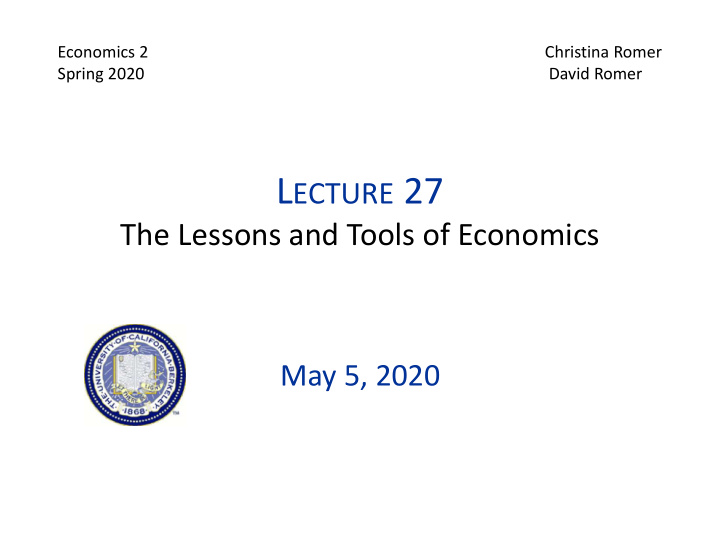



Economics 2 Christina Romer Spring 2020 David Romer L ECTURE 27 The Lessons and Tools of Economics May 5, 2020
Announcements • Suggested answers for Problem Set 6 are available on the course website. • We have posted a sample final exam and very rough sketches of the suggested answers.
Final Exam Logistics • We sent you all an email over the weekend. • Please read it! • When: Monday, May 11 th , 11:30 a.m. • You also have the option of taking it at 11:30 p.m. on the same day (to accommodate different time zones). • If you want to take the later exam, you need to email Todd Messer (messertodd@Berkeley.edu) by 5 p.m. on Wednesday.
Final Exam Logistics • The exam will be open book and open note, but not open internet. • You may not consult with others or with non- class resources. • Procedures • We will email you the exam. • You should write each answer on a separate piece of paper. • You will then scan and upload your answers to Gradescope.
Final Exam Logistics • Timing • We will email you the exam at precisely 11:30 a.m. (or 11:30 p.m. for the late sitting). • You will have 2½ hours to complete it. • You will then have 15 minutes (plus a 5 minute grace period) to scan and upload your answers to Gradescope. • If you have technical problems, you need to send a scan or photo of your exam to your GSI by 2:20, and then continue the uploading process.
Final Exam Format and Content • Strictly shorter than two midterms. • Cumulative, but with one section specifically on material since the second midterm. • Mixture of short-answer questions, problems, and multiple choice questions.
Some Advice on Taking the Final Exam • Read questions carefully. • Figure out what tool is appropriate. • Watch your time. • Always explain why a curve shifts or something happens.
Some Advice on Studying • Focus on the posted slides and your lecture notes. • Also the suggested answers to the problem sets. • Study actively; don’t just keep reading over your notes. • Redraw diagrams; think of different cases and examples and then work them out. • Focus on really understanding the tools.
Places to Get Help before the Final • GSI office hours: • Your GSI will hold their regular office hours during RRR week, unless they tell you differently. • Professor office hours this week: • Wednesday (May 6 th ), 1–3 p.m.
I. O VERVIEW
II. L ESSONS AND T OOLS OF M ICROECONOMICS
Lesson 1 • Trade-offs are everywhere.
Key Tool
Lesson 2 • There are gains from specialization and trade.
Key Tools
Lesson 3 • In a market system, prices play a crucial role.
Key Tool
Lesson 4 • Households and firms make choices to maximize their well-being. • Corollary: People respond to incentives.
Key Tools
Lesson 5 • A market system has important strengths. • Allocative efficiency. • Dynamic efficiency.
Key Tools
Lesson 6 • Interfering with the market has consequences.
Key Tool
Lesson 7 • Market failures are important, and government interventions can often improve market outcomes.
Key Tools
Lesson 8 • Market forces are a fundamental determinant of what workers are paid.
Key Tool
III. L ESSONS AND T OOLS OF M ACROECONOMICS
Lesson 1 • In the long run, output is determined by the inputs to the production process.
Key Tool
Lesson 2 • Improvements in average labor productivity are the key source of long-run growth, and technological progress is the key source of improvements in average labor productivity.
Key Tools
Lesson 3 • Changes in planned spending cause output to deviate from potential in the short run.
Key Tool
Lesson 4 • Monetary and fiscal policy affect planned spending, and so can cause or mitigate short-run fluctuations.
Key Tools
Lesson 5 • Inflation responds gradually to the deviation of output from potential, and this behavior of inflation (working through the Fed’s reaction function) brings the economy back to Y*.
Key Tools
Lesson 6 • Net exports are determined by factors affecting asset flows, not goods flows.
Key Tools
Recommend
More recommend